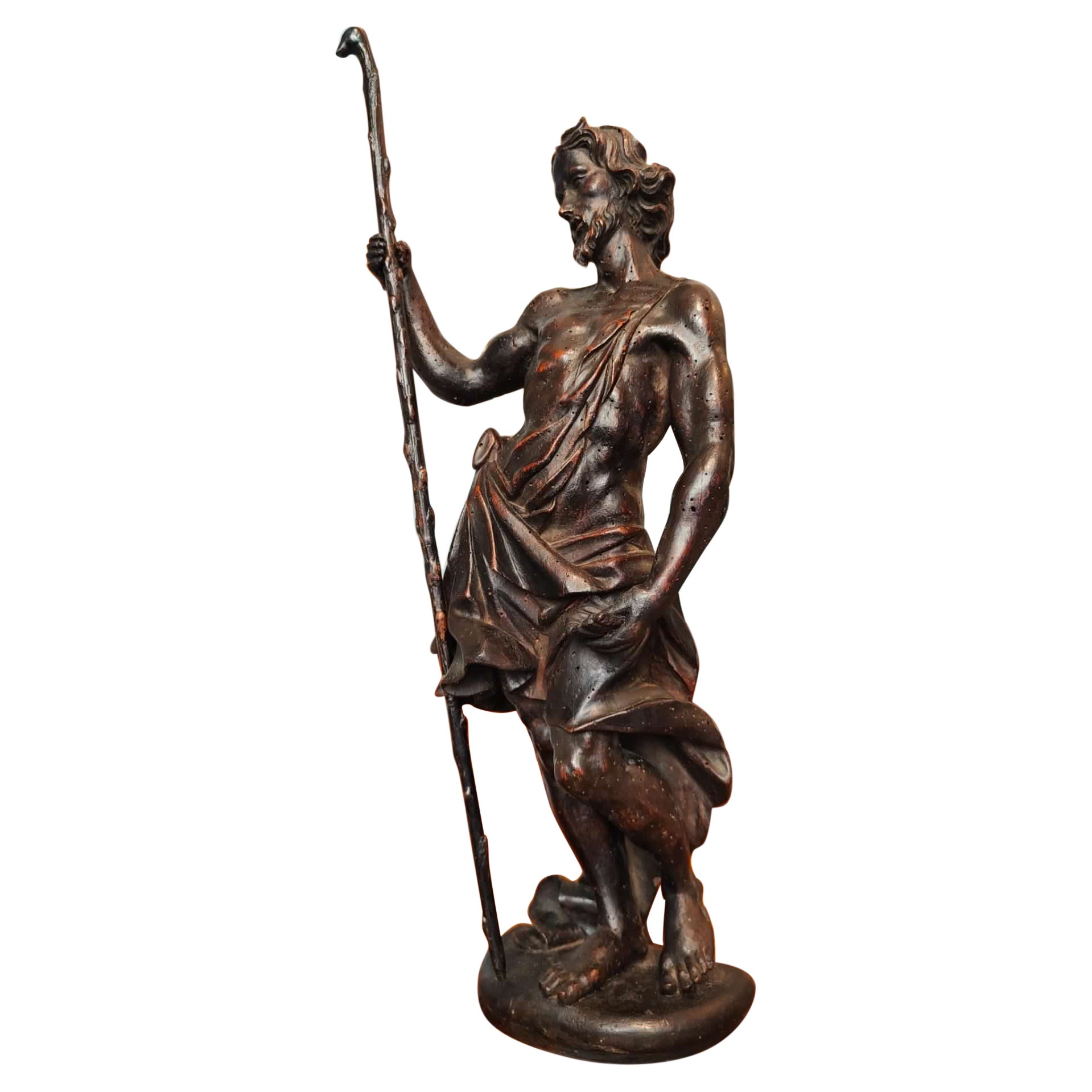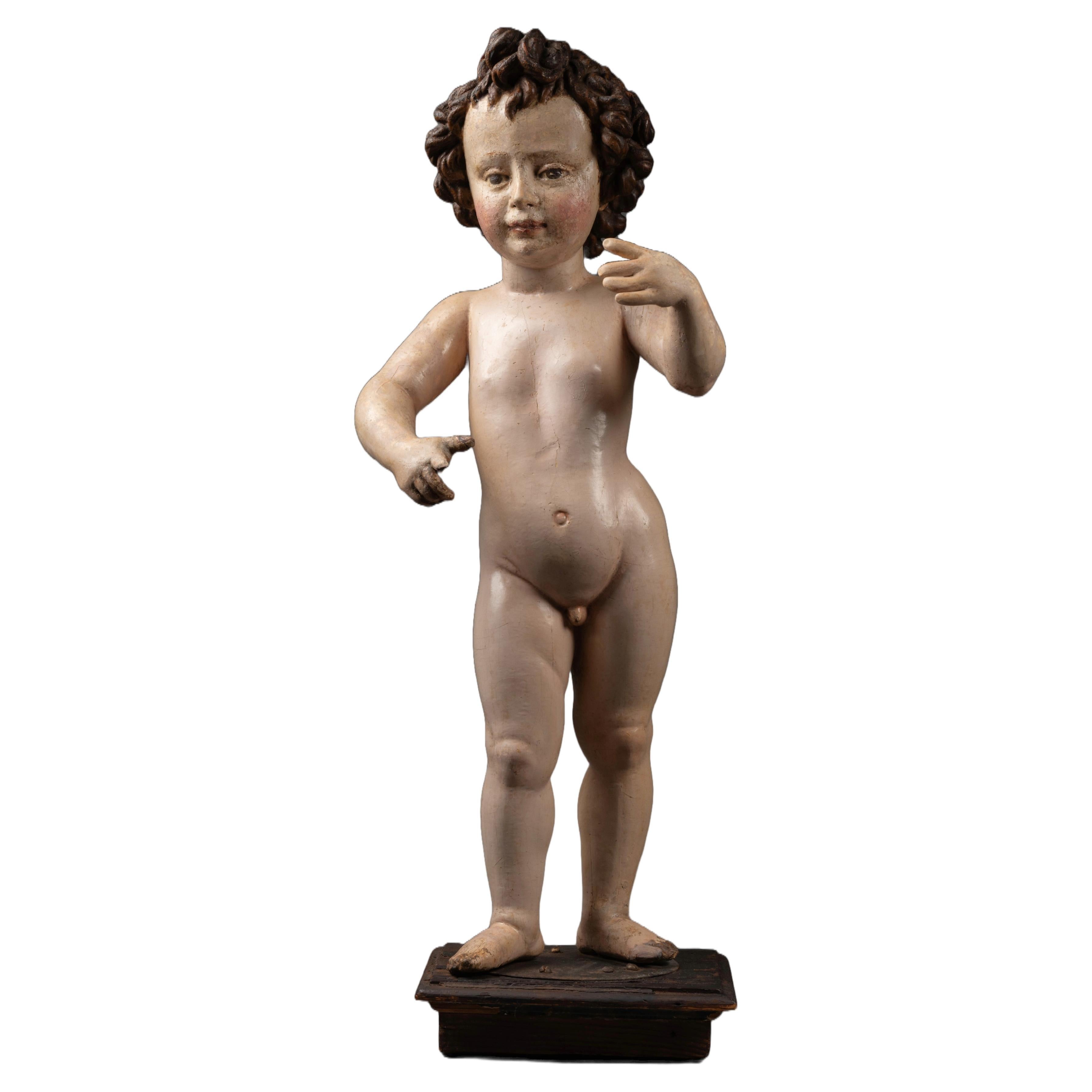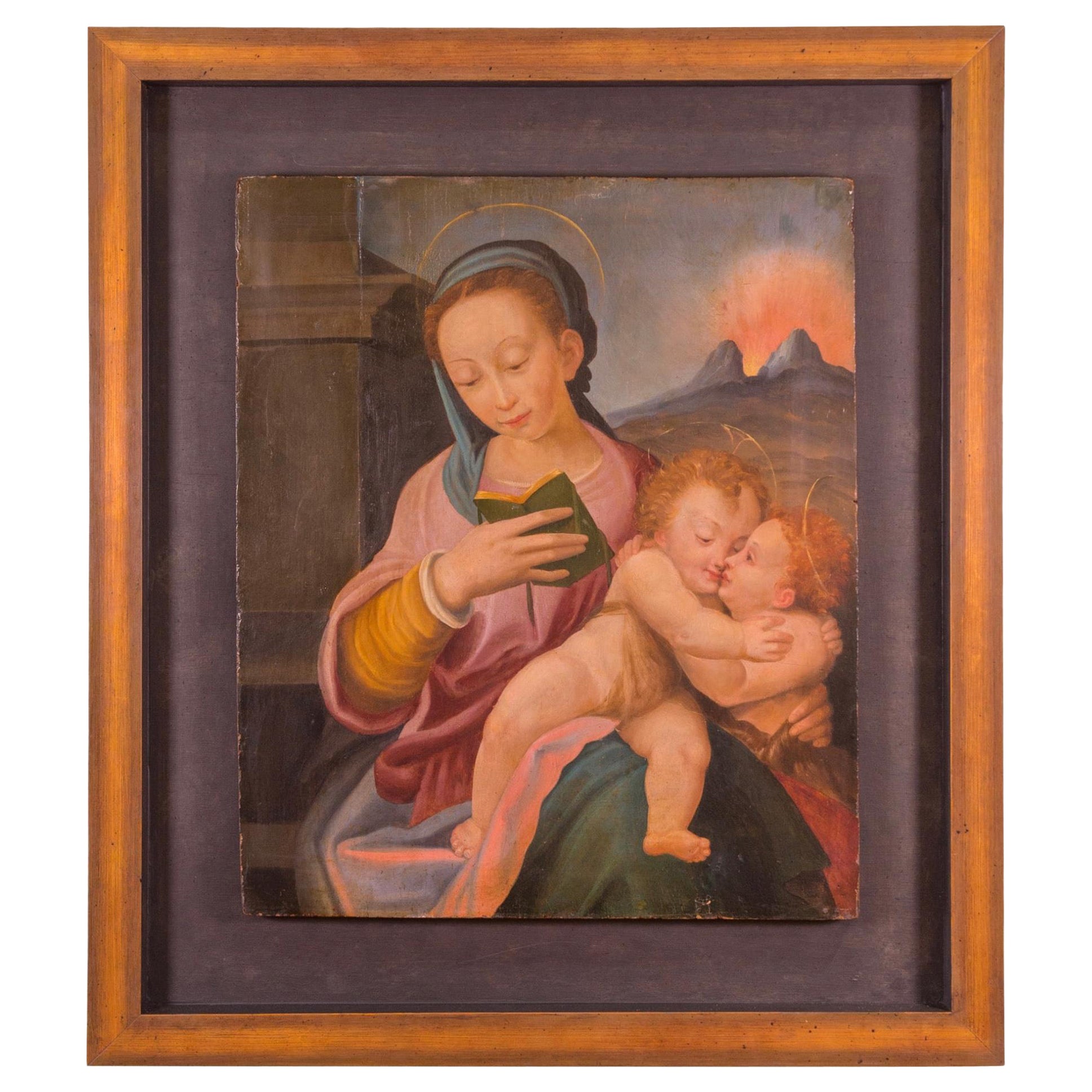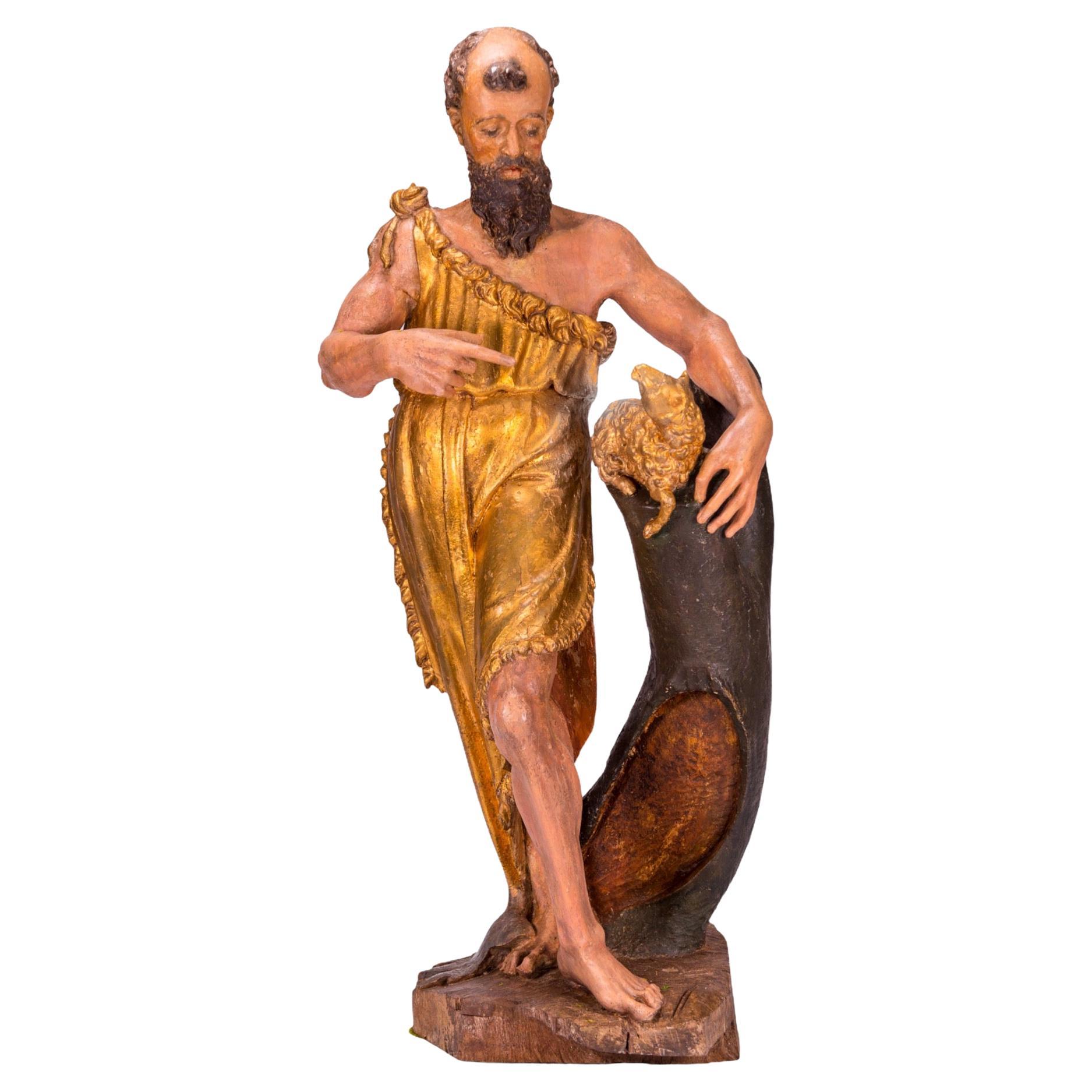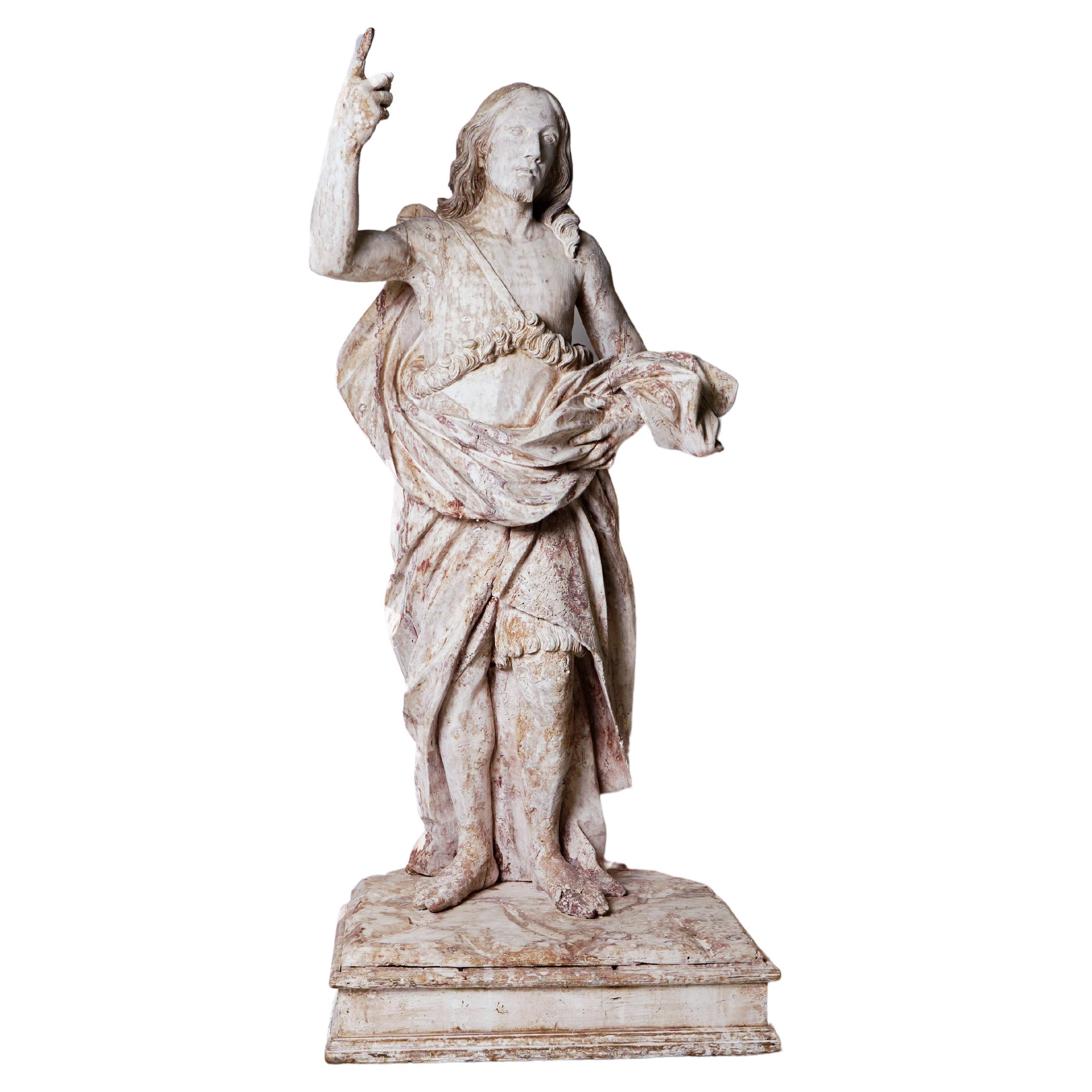Items Similar to Cercle of Juan Martinez Montañés '1568-1649', Infant St John the Baptist
Want more images or videos?
Request additional images or videos from the seller
1 of 6
Cercle of Juan Martinez Montañés '1568-1649', Infant St John the Baptist
About the Item
Cercle of Juan Martinez Montañés (1568-1649)
Infant St John the Baptist
Spanish, 17th century
H 74 cm
Saint John the Baptist is here represented naked, sitting on a rock, with the arms raised halfway. The beautiful head is crowned by curly hair forming a point above the forehead. The curly, dark hair frames a serene face with plump cheeks and small lips. The artist realized a tender figure, intended to touch the heart of the faithful.
This rare and superbly carved sculpted figure of the Infant St John the Baptist shares affinities with the work of the celebrated Spanish sculptor Juan Martinez Montañés know as “el dios de la madera”. The present figure shares the diminuitive nose, the glass eyes and small mouth with Montañés Infant models. The eyelashes and the hairs, individually delineated, as also the characteristic trapezoid shaped face are comparable with Montañés production.
Bibliography:
B.G. Proske, Juan Martínez Montañés: Sevillian Sculptor, New York, 1967, p. 51-52, figs. 31-32, 159, 182
M. Estella Marcos, La escultura barroca de marfil en España, Madrid, 1984, pp. 19-21;
J. Hernando Díaz, Juan Martínez Montañés (1568-1649), Seville, 1987;
S. L. Stratton-Pruitt and JL. Romero Torres, The Mystery of Faith: An Eye on Spanish Sculpture 1550-1750, exh. cat. Matthiesen Gallery and Coll & Cortes, London and Madrid, 2009.
- Dimensions:Height: 29.14 in (74 cm)Width: 14.97 in (38 cm)Depth: 16.93 in (43 cm)
- Style:Renaissance (Of the Period)
- Materials and Techniques:
- Place of Origin:
- Period:
- Date of Manufacture:17th Century
- Condition:Repaired: The polychromy has been restaurer in some parts. Wear consistent with age and use.
- Seller Location:Bruxelles, BE
- Reference Number:1stDibs: LU6666230800952
About the Seller
5.0
Vetted Seller
These experienced sellers undergo a comprehensive evaluation by our team of in-house experts.
1stDibs seller since 2022
6 sales on 1stDibs
Typical response time: 7 hours
- ShippingRetrieving quote...Ships From: Bruxelles, Belgium
- Return PolicyA return for this item may be initiated within 3 days of delivery.
More From This SellerView All
- Cercle of Romano Alberti, Page, Around 1530-1540Located in Bruxelles, BECercle of Romano Alberti, dit Il Nero da Sansepolcro ( San Sepolcro, 1521-1568 ) Page Mixed media : wood core, papier mâché, stucco, polychrome and gilded Italy, around 1530-154...Category
Antique 16th Century Italian Renaissance Figurative Sculptures
MaterialsStucco, Wood, Paper
- Cercle of Jacopo della Pila - Marble relief depicting a winged CherubLocated in Bruxelles, BECercle of Jacopo della Pila (Lombard, in Naples 1471-1502) Marble relief depicting a winged Cherub Naples, second half of15th century 40 x 57 x 12 cm Exquisitely carved, this relief portrays a winged cherub with cascading hair and delicate features. The cherub's plump, smooth countenance, rounded cheeks, outlined lips, and finely drawn nose emanate a sense of tenderness. The quadrangular module, is adorned with a carved frame. The relief ascends gradually, transitioning from the low relief of the wings to the high relief of the head. The rectangular frame and the subtly curved form of the artwork suggest that the relief likely adorned the upper part of an arch or a vaulted chapel. The type is that of the perspective room with a coffered ceiling decorated with figures of winged cherubs, which is found in various Neapolitan chapels of the 15th century. Coffered ceilings attest to the recovery of antiquity and the search for luxury in Renaissance architecture, first in Florence, then in Rome and Naples. The majority of the numerous family chapels and tombs built during the late fifteenth century in south of Italy employ the new formal vocabulary of the Florentine Renaissance in a self-confident manner that permitted a broad spectrum of variations. The escalating admiration for the classical world, coupled with the development of perspective, significantly contributed to the Renaissance endorsement of coffered ceilings. This artistic and constructive device drew inspiration from the intricate marble patterns observed in historical landmarks such as the Arch of Titus, the Temple of Vesta in Tivoli, the Pantheon, and the Basilica of Maxentius. A distilled product of both mathematical and artistic cultures, deeply scrutinizing the ancient world, the coffered ceiling plays a vital role in the perspective construction of space with its regular and directional geometry. The motif of the coffered ceiling decorated with cherubs in relief was introduced in Naples by Francesco Laurana in the plastic decoration of the Arch of Castelnuovo. Laurana's impact on the art scene in the south of Italy was profound. The introduction of the winged cherub into the region's artistic vocabulary bridged the gap between the classical and the contemporary, creating a synthesis that resonated with both aesthetic and spiritual sensibilities. His influence extended beyond the immediate visual appeal, shaping the cultural identity of the Renaissance in southern Italy. Although the plastic decoration of the Arch of Castelnuovo cannot certainly be ascribed to a mature Renaissance style, it was precisely on this occasion that the sculptors who worked there could get to know and export throughout the Italian peninsula that type of "Florentine classicism" which, even in the 15th century Naples, was conditioned by the Burgundian culture imported into the Kingdom by Alfonso of Aragon himself, with artists called from Spain and Northern Europe. The coffered ceiling, with its geometric patterns and Laurana's winged cherubs nestled within, became a symbol of refinement and cultural sophistication. The relief sculptures, carefully integrated into the overall design, transformed the ceiling into a celestial realm, inviting viewers to contemplate the divine while immersed in the grandeur of the Renaissance space. Similar winged cherubs appears also in the Naples cathedral. Within the renowned Succorpo Chapel, a mesmerizing marble coffered ceiling adorned with cherubs epitomizes the splendor of the Neapolitan Renaissance. The interplay of light and shadow on the textured surface of the marble coffered ceiling introduces an ethereal dimension, providing an immersive visual experience for observers. The geometric precision and the repeated patterns, reminiscent of classical motifs, establish a sense of harmony and balance that has become the hallmark of the Neapolitan interpretation of Florentine Renaissance aesthetics. Although probably intended to be admired from a distance, this cherub is intricately detailed and exquisitely rendered: the face and hair are elegantly outlined and the feathers are textured through juxtaposed lines. The marble, both figurative and decorative, adheres to the principles of balance and restrained ornamentation typical of the « Florentine Classicism ». Harmonious shapes and gracefully orchestrated curves , rooted in the classical repertoire, converge to evoke a sense of ethereal beauty. The surface displays the masterful use of a chisel to intricately carve the feathers and facial features, creating an almost abstract quality. This work is a testament to a sculptor of great skill and rich figurative knowledge, seamlessly blending classical firmness in contours with a refined treatment of the marble's surface. The combination of tradition and innovation point to a stylistic idiom from Lombardy, in particular we can find some comparaisons with the works of Jacopo della Pila, sculptor of Lombard origin working in Naples in the second half of the 15th century. He is documented there between 1471 and 1502, and is a protagonist of the Aragon Renaissance in the second half of the Quattrocento, together with the other great Northern sculptor active in the kingdom, Domenico Gagini. the first commission he received dates back to August 9, 1471, when Jacopo publicly committed to sculpting the funerary monument of Archbishop Nicola Piscicelli to be placed in the Cathedral of Salerno. The last known work is an altar ordered on July 29, 1502, by the noble Jacopo Rocco for the church of San Lorenzo Maggiore in Naples. Between these two chronological extremes (1471-1502), we must place the fervent activity of the artist, who had trained in Rome, perhaps under the guidance of Paolo Romano but also engaged in dialogue with other major artists of the city, especially Isaia da Pisa. He enriched his experience in Naples, initially drawing inspiration from the works of Domenico Gagini and later from the Tuscan masterpieces of Antonio Rossellino and Benedetto da Maiano destined for the church of Santa Maria di Monteoliveto. Jacopo della Pila's artistic personality is thus based on a complex interplay of influences, contributing to the definition of a highly personal style. Close comparaison can be made between our cherub and the winged angels reliefs...Category
Antique 15th Century and Earlier Italian Renaissance Figurative Sculptures
MaterialsMarble
- Adoration of the Magi, Flanders, 17th CenturyLocated in Bruxelles, BEThe Adoration of the Magi. Panel carved in high relief. Flanders, 17th century. Measures: 53 x 32,5 cm.Category
Antique 17th Century Dutch Renaissance Figurative Sculptures
MaterialsWood
- Massacre of the Innocents, Normandy, Late 16th CenturyLocated in Bruxelles, BEThe Massacre of the Innocents Carved oak panel Normandy, late 16th century (Collection labels on the back) Measures: 43,5 x 61 cm.Category
Antique 16th Century French Renaissance Wall-mounted Sculptures
MaterialsOak
- Terracotta Bust of Christ as the Redeemer, 15th CenturyLocated in Bruxelles, BEA terracotta bust of Christ as The Redeemer Tuscany or Emilia Romagna, late 15th century Measures: 46 x 43 x 21 cm This powerful, moving bust of...Category
Antique 15th Century and Earlier Italian Renaissance Figurative Sculptures
MaterialsTerracotta
- The flagellation - Brabant, circa 1560Located in Bruxelles, BEAltarpiece group representing the flagellation Brabant, circa 1560-1580 Carved wood, polychrome, and gilded 50 x 38 x 7 cm At the center of the group, Christ stands upright, leaning...Category
Antique 16th Century Belgian Renaissance Figurative Sculptures
MaterialsWood
You May Also Like
- Sculpture depicting St. John the BaptistLocated in Alba, ITWooden sculpture of remarkable quality depicting St. John the Baptist shown with staff and shell in his left hand. The figure is defined and cared for in every detail, and even small...Category
Antique 17th Century Italian Other Busts
MaterialsWood
- The Infant St John the Baptist, a 17th Century Sevillian school Spanish BaroqueLocated in PARIS, FRThe Infant St John the Baptist, A first half of 17th century Sevillian School Cercle of Juan de Mesa Velasco (Córdoba, 1583 - Séville, 1627) Polychrome and carved wood Height: 65 cm ...Category
Antique Early 17th Century Spanish Baroque Figurative Sculptures
MaterialsWood
- The Madonna with Christ Child and the Infant St. John the Baptist, Hand PaintedLocated in North Miami, FLLate 16th century Italian school oil on a wood panel painting of The Madonna with Christ Child and the infant St. John the Baptist. Mount Vesuvius is erupting in the background. This painting was part of the collection of Fred B...Category
Antique 16th Century Italian Wall-mounted Sculptures
MaterialsWood
- Sculpture of John The Baptist, 16th CenturyLocated in North Miami, FLEarly 16th Century Spanish gold gilded and polychromed carved wood sculpture of John The Baptist.Category
Antique 16th Century Spanish Renaissance Figurative Sculptures
MaterialsGold Leaf
- Rare 18th C Wooden Statue of St. John the BaptistLocated in Chicago, ILThis exceptionally life-like antique sculpture is carved from linden wood and once decorated a French church or cathedral. The figure stands authoritatively, with right arm raised and index finger extended toward heaven. It probably stood on a base in a side chapel. According to Christian iconography of the period, this gesture signifies that salvation comes only through baptism. The figure wears a girdle of animal fir, probably from a bear, making symbolic reference to St. John the Baptist's life in the wilderness of Judea, between Jerusalem and the Dead Sea. The elegantly carved robe is a baroque element that adds a sense of motion and energy to the artwork. Originally, the sculpture was polychromed, but the original pigments have weathered away and been replaced with whitewash. Repairs, losses, and insect damage are minor and expected due to great age. many vintage and antique religious sculptures...Category
Antique 18th Century French Figurative Sculptures
MaterialsWood
- St. John the Baptist, Polychromed Boxwood, Baroque, 17th CenturyLocated in Madrid, ESStylistically, and to appreciate the stylistic differences, compare with the San Juan Bautista of the "Altarpiece of San Juan Bautista" by Juan de Juni and Inocencio Berruguete, dated in 1551 and today in the National Museum of Sculpture of Valladolid, or with the Sanint John the Baptist by Alonso...Category
Antique 17th Century European Baroque Figurative Sculptures
MaterialsBoxwood
Recently Viewed
View AllMore Ways To Browse
Spanish 17th
Spain 17th
Used Furniture St Johns
Small Lips
Antique Furniture St Johns
Crown Saint
Antique Saint John
J B G
Wood Cat Sculpture
19 Century Spanish
John Baptist
John The Baptist
Antique Glass Cat
Polychrome Saint
Spanish Wood Saint
17th Century Spanish Carved Wood
Antique Eye Glasses Frames
Antique Eye Glass Frames
